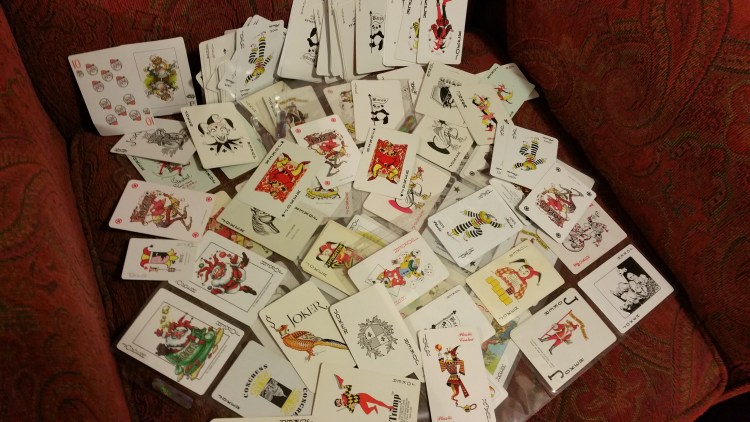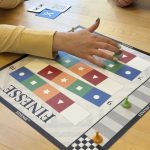Joker Playing Cards are beautiful, fun, and easy to collect.
Collecting the Little Fool

Collecting the Little Fool
Joker Playing Cards are beautiful, fun, and easy to collect.
by Jude Goodwin © Great Bridge Links
“A joker is a little fool who is different from everyone else. He’s not a club, diamond, heart, or spade. He’s not an eight or a nine, a king or a jack. He is an outsider. He is placed in the same pack as the other cards, but he doesn’t belong there. Therefore, he can be removed without anybody missing him.” Jostein Gaarder, The Solitaire Mystery
Years ago I had the idea that collecting jokers might be a fun thing to do. I already had a drawer full of decks of playing cards, many of them old, perhaps jokers would be easier and take up less room! Now I find I have a binder full of individual joker cards – but, what are they really worth? Is collecting jokers, or any kind of playing cards, a worthy pastime – or should we stick to hockey cards and Pokemon?
Wikipedia describes the Joker as: a playing card found in most modern card decks, as an addition to the standard four suits (clubs, diamonds, hearts and spades). Originating in the United States during its civil war, the card is unique in that it lacks an industry-wide standard appearance. Created as a trump card for Euchre, it has since been adopted into many other card games where it may function as a wild card.
The fact that there is no ‘industry-wide standard appearance’ is exactly what I love about the joker playing card. It’s fun to collect – always looking for a design I don’t yet have. And jokers are happy, colourful, often designed after the jester or fool. There are usually two Jokers per deck and often they are noticeably different. Sometimes one is full colour, the other is black and white, sometimes one will have a bigger image than the other or sometimes, echoing suit colours, one will be red and one black. This is because there are card games that give a different value to each joker, so the differences in design help tell which one is the more valuable.
In Australia, the Joker in the Queen’s Slipper brand of playing cards depicts a Kookaburra, the ‘laughing’ bird so in their games the Joker is often referred to colloquially as “The Bird”. In Portugal, Litografia Maia has printed French decks where the Joker figure is substituted by a donkey head. It is intended to be used in Burro em pé (“standing donkey”).
THE JOKER’S HISTORY
The extra playing card, which would eventually be called the Joker, was invented by Euchre players sometime in the 1860s in the USA. Originally it was called ‘the Best Bower’. These extra cards were first introduced into American packs of playing cards in 1863 but it took a little longer to reach England appearing overseas around 1880.
This short history can make it a perfect collectors’ piece – only 153 years worth of joker cards to find!
IMPORTANT ADVICE FOR COLLECTING JOKERS
If you’re planning to start collecting jokers, right now, from scratch, I have some great advice for you. I wish someone given me this advice when I started all those years ago!
-
Save both Jokers
As mentioned earlier in this article, the two jokers in a deck can be different. A set of jokers from a particular deck is more valuable than a single joker.
-
Catalog your collection
Before you throw away or put aside the accompanying deck, write down in a journal or a spreadsheet the important catalogue information for your card. Many jokers have no mention on them of any of these details so don’t think you’ll be able to ‘go back later’ to get this done. Sadly I did not think of this years ago when I first started my collection so now I have a hundred or so Jokers and no idea how to catalog them So do it now! Here are details you should keep:
- Manufacturer
- Brand name, including brand number, and the name of the deck, if applicable (e.g. Congress #606 – Moonfairy)
- Date of issue
- Condition
- Type of deck (e.g. standard, advertising, souvenir, etc.)
- Cost and/or value if you can find it
- Hochman or other reference – see below for more info on Hochman
- Other pertinent data (e.g. gold edges, damaged assessment, etc
- Catalogue reference number for your records
-
Store properly
Because Jokers are so beautiful you’ll of course want to be able to show them off. I recommend you purchase a hard cover 3-ring binder and a dozen or so 9-pocket card collecting pages. These can be found at card shops but I’ve also found them at stores such as Walmart and Target. The kids use them to store their Pokemon and other TGC cards so they’ve become easy to find over the past decade.
You can also find cardboard archival card boxes which would be a good idea for your doubles. Again, though, be sure to make a note of any additions to both your binder and your boxes. This will come in very handy if you happen to meet up with a group of fellow collectors and want to start trading. Because –
The less you have to handle your cards the better – mint cards are the most valuable.
VALUING PLAYING CARD COLLECTIONS
OK you have a great joker collection started, but what is it worth?
In 1976 Gene Hochman published his Encyclopedia of American Playing Cards which included a price guide for all the decks listed. The book was updated and its current incarnation, published by Tom and Judy Dawson, is dated 2000. It catalogues all playing cards from the late 1700s to the 1930s, not just jokers. Click here to view this book on Amazon. http://amzn.to/28KcyI3
In 2015, Tom and Judy Dawson with the help of a worldwide group of playing card collectors, published an update that valued every entry in Encyclopedia. You can find that book here http://amzn.to/28N7MbQ
You’ll notice, each entry has three values based on the condition of the cards. These values are:
Mint – a perfect card showing no signs of use.
Excellent – a card that has been occasionally used, but still in first class condition. Gold edges would still be intact.
Very Good – A card showing signs of repeated use, but still nice. There would be no serious creases or bent/broken corners.
HAPPY COLLECTING!
Now it’s time to get your collection started. You can begin by going through the decks of cards in your home. If you can’t find the catalog information on the box, you might find it on the Ace of Spades. You can visit your local thrifts stores and antique shops, and you can visit some of the great websites listed below. Maybe join a club or attend a convention!
This website (Dot Pattern) presents an amazing collection of joker designs.
There are a number of clubs supporting the playing card collecting hobby. Two of these are essentially American clubs, albeit with many overseas members: 52+Joker, a club for deck collectors with an emphasis on American cards and The Chicago Playing Card Collectors’ Club which caters to both deck and single card collectors.
In Europe there are a number of clubs and England is the home of the International Playing Card Society, a group with members from around the world, whose main emphasis is on education and research into the history and use of playing cards.








